
If you truly believe that food is medicine and you know from experience that many wild foods can be foraged for free, then there should be nothing standing in the way between you and a nourishing herbal tonic.
But, you better get ready to step outside the concept of brand names and pre-packaged food. There will be none of that here, except for the apple cider vinegar, if you haven’t already made a large batch at home.
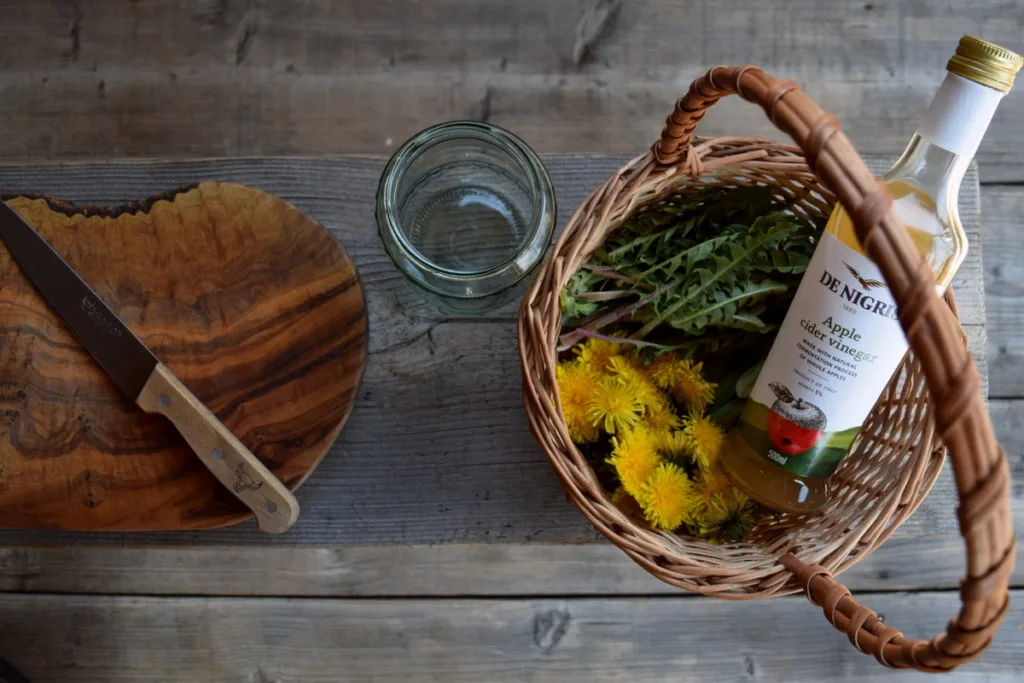
You must also be willing to accept the unknown (hopefully even enjoy it!) as you leave some commercially acquired tastes and feelings behind .
In a recent conversation about what we eat and how we store our food, it came to talk about how we eat nettles, among other “weeds” from our yard and garden.
The reaction was that nettles are disgusting and spiteful little plants… Obviously they have never eaten them instead of spinach in a delicious quiche.
If you are the curious type and would like to get to know nettle a bit more before deciding, this post will shed some light on how to pick them, also giving you 11 non-stinging ways to use nettles. Once you figure out how to handle them, they are spring garden gems. I promise.
For spring tonic reasons, we have included nettle in our herb infused vinegar, though you will find that this recipe is flexible and forgiving.
If you can’t come across any, or don’t want to include them in your herbal vinegar, simply leave them out and replace them with another wild plant that you do love.
Creating an infused vinegar is one of the best ways to extract minerals from fresh spring herbs.
What eating seasonally has to do with making herb infused vinegars
Long before supermarkets touted fresh fruits and vegetables at all times of year, people ate what grew locally and in season. And yes, this included wild greens – the reliable perennial plants that come up long before tender lettuce and baby garden greens emerge.
- ramps (wild garlic)
- three-cornered leek
- dandelions
- alfalfa
- plantain
- sorrel
- purple dead nettle
- henbit
- raspberry leaf
- wild strawberry leaf
- hawthorn leaf
- and much more!
All of these are early spring edibles, and they can all be appreciated in their own special ways.
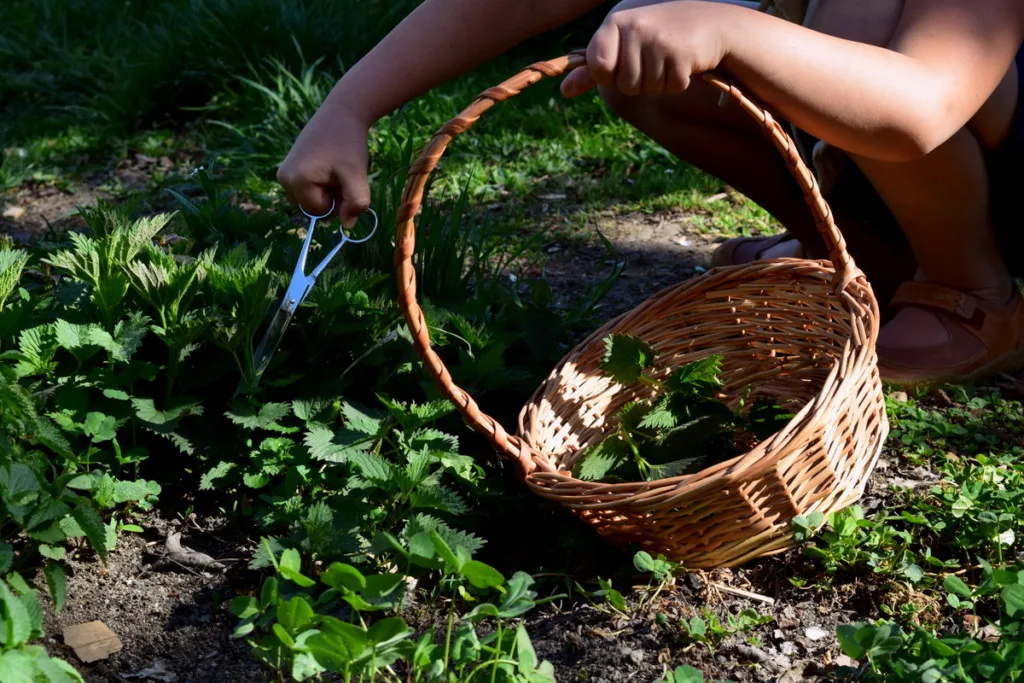
In the quest to reduce food miles, eating as seasonally and locally as possible makes perfect sense. If you want to eat diversely, however, don’t make the mistake of waiting for summer when the largest amount of veggies and fruits are growing in your garden. Instead, befriend some new plants!
Eating seasonally can help to save you money (especially when you grow your own garden), it allows you to eat fresh food that tastes far better than store-bought and is full of nutrients, it also puts less strain on the planet via transportation and storage.
So, when you make an herbal infused vinegar using a few handfuls of foraged plants from your backyard, not only are you doing your body good, you are also carrying out something wonderful in the name of self-reliance and seasonal eating too.
How to make an herbal infused vinegar
Although spring is perhaps the most popular time to make an herb-infused vinegar with fresh ingredients, it is not the only time you would want to make one.
Infused vinegars can be made all throughout the year, even with dried herbs.
In that case, you will want to heat the vinegar first, then wait just one week till it is ready. As refreshing as it is to accomplish your goal quickly, the shorter wait time also means that the flavors will not be as refined as fresh ingredients sitting in vinegar at room temperature for 3-4 weeks.
My advice for you is to try both ways of making herb-infused vinegars, they are far better than anything you can buy at the store.
Step 1 : Gather and forage for ingredients
To get started, step outdoors, take a deep breath of fresh air and forage for the wild plants you intend to use in your infused vinegar.
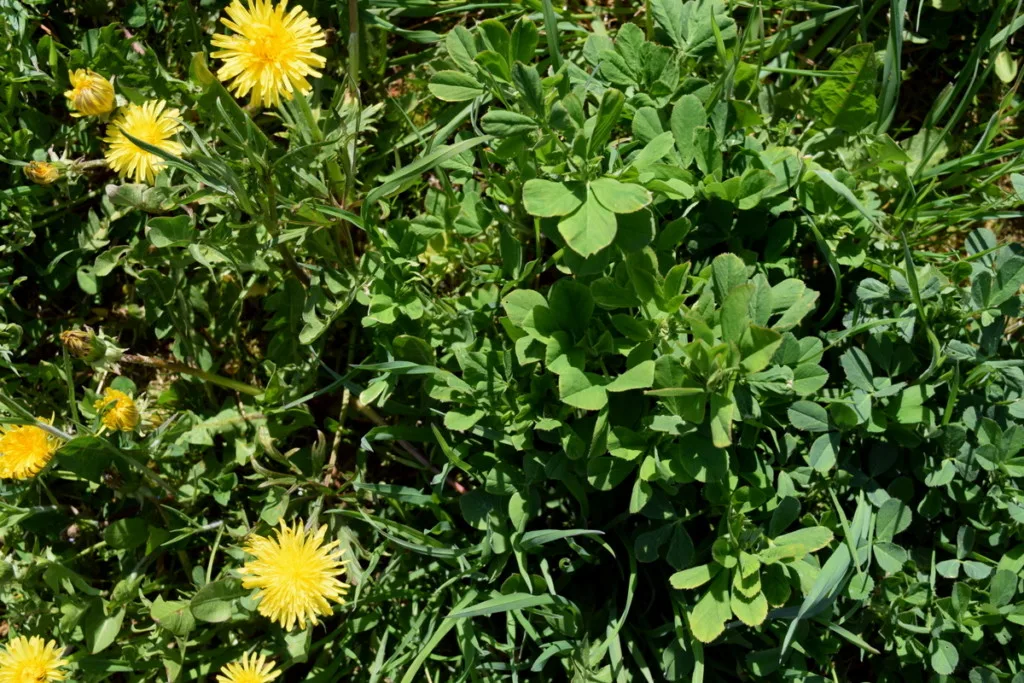
Here we are using just four ingredients. To keep the infused vinegar simple, yet delightfully flavorful:
- stinging nettles (Urtica dioica)
- alfalfa (Medicago sativa)
- dandelion (Taraxacum officinale)
- plantain (Plantago lanceolata)
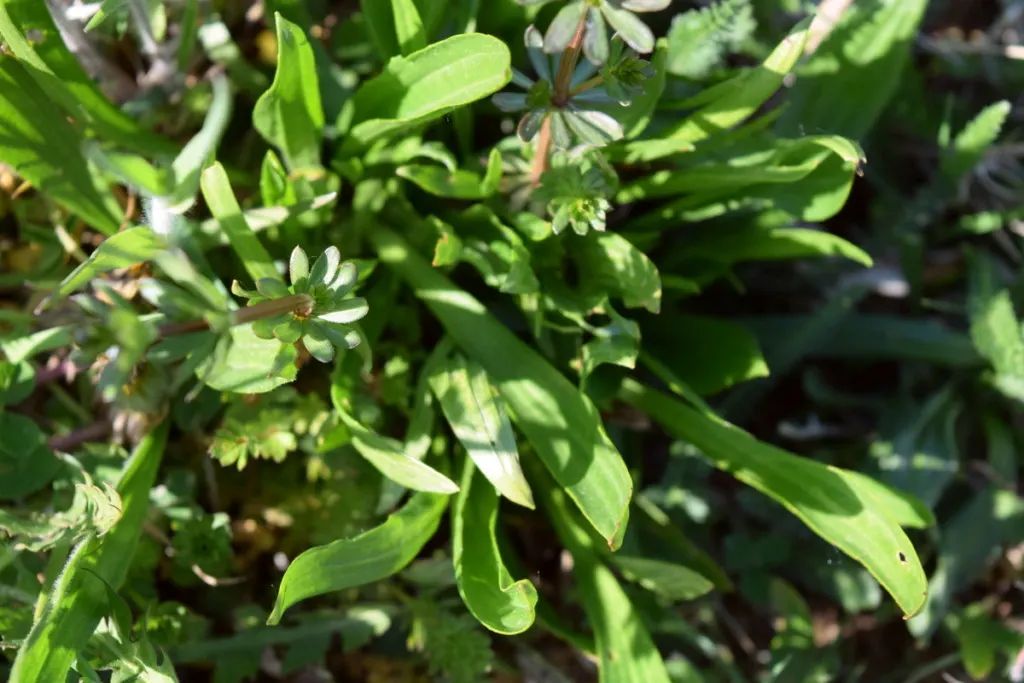
Harvest just as much as you need at one time, and you will easily discover that there is plenty left for the bees. A couple handfuls of fresh greens should be enough material to loosely fill an average size jar.
Keep in mind that children can and should be encouraged to lend a helping hand in harvesting from the wild. Teach them well, and they can pass this essential knowledge on to future generations.
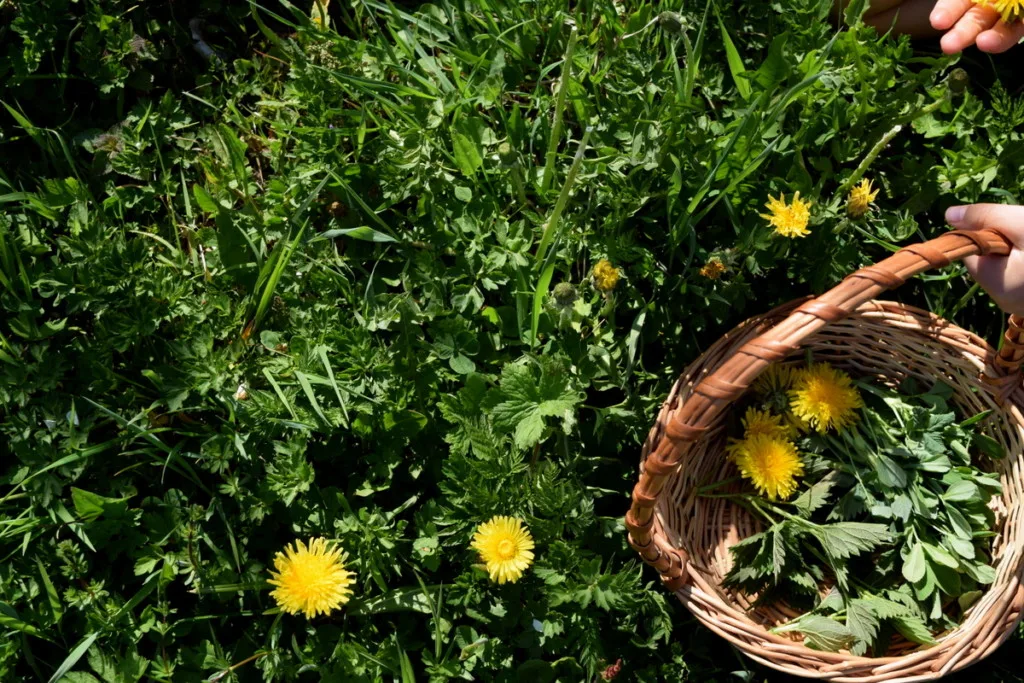
Besides a handful or two of fresh herbs, you will need approximately 3 cups of organic apple cider vinegar, or enough to fill your jar.
Step 2: Shake, wash and chop your wild greens
Once you have harvested all the herbs you wish to add to your infused vinegar, you will want to make sure they are clean as can be.
Some people may choose to rinse them with running water, then let them dry out on a baking sheet before chopping.
We give the plants a shake as we harvest them, then leave them to sit in a basket for several minutes, allowing smaller insects to escape. If you are using roots, you will want to be sure to wash those.
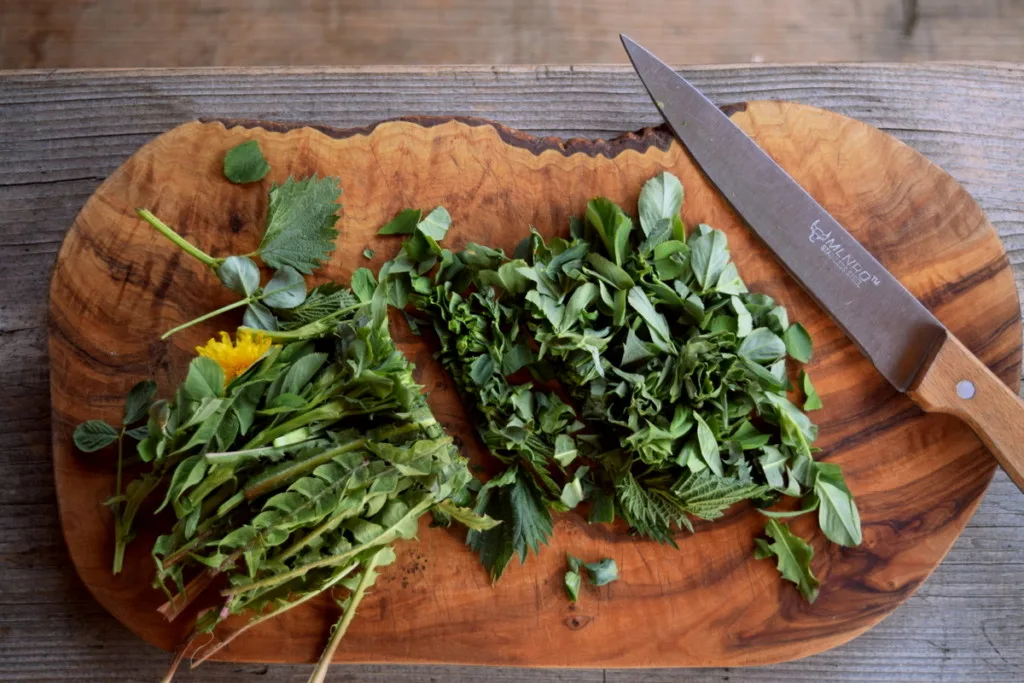
Next, chop up your herbs roughly to increase the surface area of the plant. Chopping, or ripping them, will result in a more intense flavor.
If you choose to add the herbs whole, your infused vinegar will be much milder. There is no wrong way to do it, just a million different results.
Step 3: Fill the jar and add the vinegar
When you are done quickly chopping your herbs, add them loosely to the jar and pour apple cider vinegar to the top.
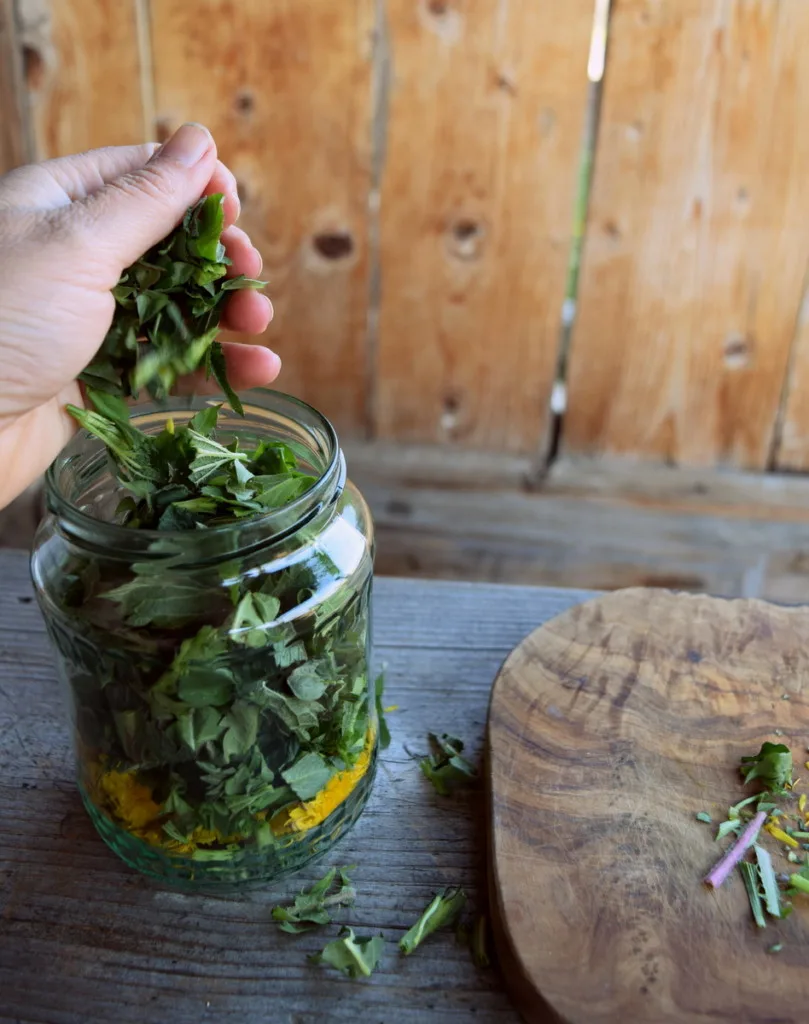
Every few days you may want to push the herbs down with a wooden spoon. At the same time, avoid using a metal lid to cover your vinegar, potentially giving it the chance to corrode. Instead, cover your jar with a glass lid, or use a plastic/parchment paper barrier for protection.
A note on vinegars
Though organic apple cider vinegar is our personal preference, there is no need to feel limited by it.
White wine vinegar is also an excellent choice for making herbal infusions, as is red wine vinegar in a pinch.
It is best to avoid distilled vinegar, however, as it is quite harsh on the palate.
Step 4: Sit and wait
Some recipes say to wait two weeks until you strain and decant your herb-infused vinegar. However, if you want to really feel the herbs and reap their nutritional benefits, let it sit for 3-4 weeks in a cool, dark place.
After some weeks have passed, all that is left to do is to strain the herbs and store your herb-infused vinegar in a clean jar. Compost the herbs to practice zero-waste.
Shelf life of your herb-infused vinegar is approximately 6 months, though it will likely be gone far before that!
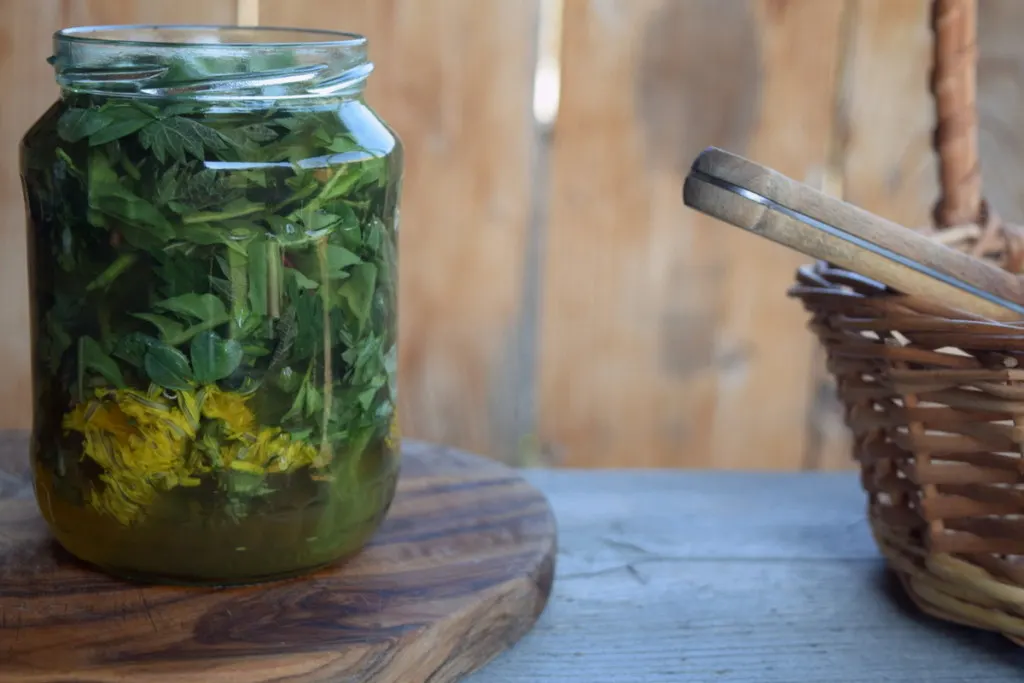
Other herbs to add to your herbal vinegars
Once you have made your first batch of an herb-infused vinegar, you will soon be ready to experiment with the next one. After all, new flavor combinations will come in handy when deciding how to dress your next salad.
There is no need to worry about specific amounts/weights of herbs, so long as the proportions seem right. Through a little of trial and error you will find an herbal blend that suits your taste buds best.
When making an herbal infused vinegar, you may also consider adding:
- chive blossoms
- comfrey leaf
- dandelion root
- dill (leaf or seed)
- fennel
- lemon balm
- mint
- nasturtium
- oregano
- rosemary
- sage
- tarragon
Use what grows in your garden or your backyard, use plant materials from the farmers market or the store. Whatever you do, just try it and enjoy it!
How to use your herb-infused vinegar
There are so many benefits to consuming apple cider vinegar that many of you already know, so we won’t cover them here.
Truth be told, apple cider vinegar is one of the most basic ingredients that you should have in your kitchen – both for eating and cleaning the house!
Now, that your herbs have sat in ACV for about a month, you’ll have the additional benefits of those wild greens as well.
When your herb-infused vinegar is ready for sampling, apply it liberally to salads, add it to your roux when coating a cold potato salad, drop a splash or two into soups and stews to give an exciting burst of flavor. In essence, use it anywhere you would normally use vinegar.
Only now, it is vinegar with a twist. A delicious, nutritious herbal twist.

Get the famous Rural Sprout newsletter delivered to your inbox.
Including Sunday musings from our editor, Tracey, as well as “What’s Up Wednesday” our roundup of what’s in season and new article updates and alerts.

